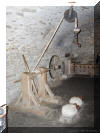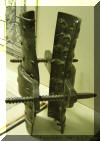Torture
by Brian A. Pavlac,
Ph.D., Professor of History

Buy the Book!

|
|
Torture
|
|
|
This page provides links and explains some of the phenomenon of torture, especially as applied to the witch hunts. It is still under some construction.
Torture has become a matter of current events rather than a quaint practice from people long ago or far away.
Since the terrorist attacks of 9/11 American involvement in accusations of torture range from treatment of enemy combatants at Gitmo (the US military base at Guantanamo on the island of Cuba) to the Abu Ghraib prison in Iraq, to "extraordinary rendition" (or secret transporting) of suspect terrorists by the CIA to black sites (secret facilities in foreign countries where torture may be carried out). In July 2014 the European Court of Human Rights held Poland accountable for its involvement in these "extraordinary renditions" (see articles here, here, or here).
In 2010-2011 there was the case of Private Manning as reported by the Baltimore Sun or Salon and the 2012 ruling of a United Nations commisioner on Human Rights.
President Obama acknowledged and explained the issue of torture since 9/11 on August 1, 2014. For a cartoon commentary on that speech, click here.
One of the trickiest issues is the definition of Torture. Do we know when we see it?
The United Nations Convention on Torture (or <http://www.un.org/documents/ga/res/39/a39r046.htm> or <http://www.hrweb.org/legal/cat.html>, proposed in 1984, in force by 1987, ratified by the USA in 1994) states:
any act by which severe pain or suffering, whether physical or mental, is intentionally inflicted on a person for such purposes as obtaining from him or a third person information or a confession, punishing him for an act he or a third person has committed or is suspected of having committed, or intimidating or coercing him or a third person, or for any reason based on discrimination of any kind, when such pain or suffering is inflicted by or at the instigation of or with the consent or acquiescence of a public official or other person acting in an official capacity. It does not include pain or suffering arising only from, inherent in or incidental to lawful sanctions.
The last sentence exempts punishment from the definition of torture and the UN would hesitate to ban it. Yet, outside of criminal punishment, torture is unacceptable, according to this treaty. The UN convention also states: No exceptional circumstances whatsoever, whether a state of war or a threat of war, internal political instability or any other public emergency, may be invoked as a justification of torture. See also the UN Declaration on the Protection of All Persons from Being Subjected to Torture and Other Cruel, Inhuman or Degrading Treatment or Punishment of 1975 <http://www.unhcr.org/refworld/docid/3b00f1c030.html> <http://www.un-documents.net/a30r3452.htm> or <http://www1.umn.edu/humanrts/instree/h1dpast.htm> or <http://www.state.gov/documents/organization/100296.pdf>.
The quite common idea of a crimen exemptum or an exceptional crime or emergency allows for exemptions from legal procedure, ranging from violating rules of evidence to applying torture. In the Witch Hunts, the fear of magic and its power often allowed authorities to excuse themselves from strict observance of legalities.
Another excuse for allowing torture is the ticking time bomb myth or the idea that some disaster may occur if someone isn't tortured into telling the truth soon enough. Such emergencies with knowing perpetrators under a tight deadline are drawn almost entirely from fiction, not the real world.
This page, therefore, focuses on torture as inflicting pain according to the law. How private individuals, sick sadists, or criminals might inflict agony can certainly be defined as torture, but is not under consideration here. Suffering inflicted by authorities, states, governments, or legally constituted officials are particularly relevant to the Witch Hunts.
Questioning
Interrogation (including lying, good cop/bad cop, some discomfort (bright light, thirst, pressure for need for restroom, isolation)
Enhanced Interrogation Techniques
cruel, inhuman, and degrading treatment (as mentioned in the McCain Amendment to the Dept. of Defense Appropriations Act, 2006 (listed as H.R. 2863 of the 109th Congress, Amendment s. 10909).
severe pain and suffering
or
equivalent in intensity to the pain accompanying serious physical injury, such
as organ failure, impairment of bodily function, or even death. (according to
the
Bybee Memo of 2002
or
here) or "a substantial risk of death... extreme physical
pain;... a... significant loss or impairment of the function of a bodily member,
organ, or mental faculty " (according to
Military Commissions Act of
2006 from the 109th Congress, referenced as S. 3930.ENR). President
George W. Bush through signing statements refused to acknowlege limits on
his authorization to torture, (see
this article).
Authorities have two main purposes for torture, either information or punishment. Some scholars of torture and law codes (such as the UN Convention) leave out the punishment side of torture.
Intimidation and cruelty might be two more possible motives for torture. Intimidation would seek to discourage people from certain behaviors or beliefs through the fear that they also might be tortured. Some authorities might simply enjoy inflicting pain on others. Civilized people would probably claim to avoid such uses of torture, although it seems human nature easily slips into the torturer mentality (see the Stanford Prison Experiment). Authorities might also conceivably use torture for behavior modification, as per fictional accounts such as A Clockwork Orange or 1984. Such methods, however, could be properly included under the punishment (and rehabilitation) aspects of torture.
Torture usually follows RULES
The person is presumed guilty.
The torture is authorized by legal procedures.
The torture is observed and recorded.
The torture is of limited duration.
The torture is carried out with increasing intensity.
The torture leaves no permanent physical damage to the victim.
The torture does not kill the victim.
Victim must repeat confession outside of torture.
During the witch hunts, torture expanded the number of victims as "confessions" implicated more people as witches. Where torture was not used, or was carefully regulated, hunts were non-existent, rare, or limited. Below are examples of methods and tools of torture used in the European Witch Hunts.
| 1st degree--ask for confession | 2nd degree--threaten torture | 3rd degree--prepare for torture |
| 1st degree--ask for confession | 2nd degree--threaten torture | 3rd degree--prepare for torture | 4th degree--screws | 5th degree--rack |
| Threatening | Degrading | Isolating |
| Discomforting: | Pulling: |
Expanding: |
Striking: |
| Judas cradle; fork; dunking; heat or cold |
 strappado; strappado;rack; ladder |
force feeding |
Newgate Prison beating cane/rod; whip |
| Mutilating: | Crushing: |
Burning: |
|
| flaying; whipping; gouging; plucking; pulling off nails; pins |
 screws; screws; twisting ropes; garrote; pressing |
hot irons; scalding water; fire; hot oil; fat |
For most crimes before 1800, torture during the investigation and trial could be supplemented during the punishment. The attitude of the Enlightenment, such as in the U.S. Constitution, Amendment VIII nor cruel and unusual punishments inflicted, helped to end the use of torture in punishment. The tendency of Western nations has at least officially been to moderate the cruelty used in punishment. Most crimes are punished today by fines, imposing community service, or confinement (house arrest or imprisonment). An allegedly common goal of modern imprisonment is rehabilitation: reforming criminals into good citizens. The conditions of many modern prisons, however, which include beatings and rapes by fellow prisoners, might be considered a form of torture.
| Degrading: | Striking: | Mutilating: | Isolating | Executing: |
| pillory/stocks; hard labor; fiddles; weights; signs | flogging; beating; caning | flogging; branding; chopping | solitary confinement: for evaluations that such is torture see Atul Gawande in The New Yorker; Dr. Jeffrey Metzer in a journal of Psychiatry Law; |
hanging; burying alive; immuring; starving; drowning; burning; boiling; breaking on the wheel; impaling; sawing; ripping with tongs; flaying; disemboweling; drawing and quartering; beheading |
The United States is alone among modern industrialized Western states still to execute criminals. Even so, contemporary capital punishment in America officially aims to reduce the suffering of the condemned, compared to execution methods of the past. Methods still used in the various state and federal executions include hanging, firing squad, the electric chair, the gas chamber, and lethal injection.
Medieval Crime Museum: Brief web material covering an excellent criminal history museum, Kriminalmuseum, in Rothenburg-ob-der-Tauber, Germany.
Historical Torture Museum: From a traveling exhibition based on exhibits from the Medieval Criminal Museum in San Gimignano, Italy. Includes some pictures and reflections.
Newgate Calendar: 18th-19th-Century English book listing criminals and punishments. Includes some witches among them (e.g. Mary Bateman 1809, Thomas Colley, 1751).
The Proceedings of the Old Bailey, London 1674 to 1834: Searchable database of over 100,000 crimes, including a few "witches."
Reggio, Michael H. History of the Death Penalty: Good brief history connected with a PBS Frontline show about the execution of a double murderer in Texas.
Torture list of Cologne 1757: A list of the prices charged to victims of torture. Although part of a page describing autos-da-fé at an atheist website attacking atrocities by Christians, the source reflects genuine, and ironic, cruelty.
Tyburn Tree: Excellent site includes links to primary source pictures, poems, speeches, literary references, etc. about executions in Early Modern England. Mostly about normal criminal executions, but relevant to witch punishments. [Created by Zachary Lesser of Columbia, then located at the University of North Carolina, expanded, maintained by Charlie Mitchell, who has restored it in blog form].
Video of Torture in UAE, 2009: and excerpts from a tape of the torture of an enemy of the UAE regime. Full story here.
What Is Torture? An interactive primer on American interrogation by Emily Bazelon, Phillip Carter, and Dahlia Lithwick: While the primer is more about modern torture, it provides good definitions and illustrations of motives and techniques.
Chinese Practitioners Reenact Torture Methods Used in Jiamusi Forced Labour Institute, Heilongjiang Province (Photos): Recent experiences.
The Right to Freedom from Torture, or Cruel, Inhuman or Degrading Treatment or Punishment: List of relevant treaties.
Interested in ending torture?
Ministry of Public Witness, Pennsylvania Council of Churches <http://pachurchesadvocacy.org/index_files/Page1281.htm>.
National Religious Campaign Against Torture (NRCAT) <http://www.nrcat.org/index.php> or <http://www.nrcatactionfund.org>.
Counter Terror with Justice Issues, Amnesty International <http://www.amnesty.org/en/how-you-can-help>.

|
|
URL: http://departments.kings.edu/womens_history/witch/torture.html
|